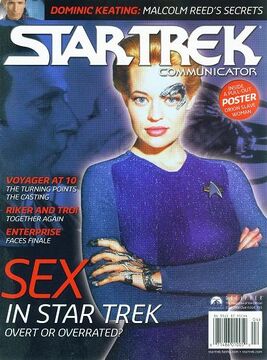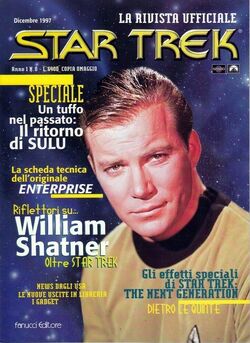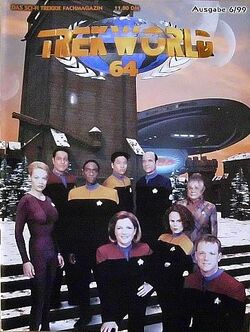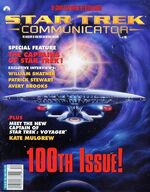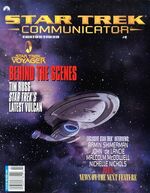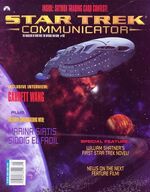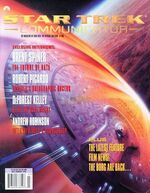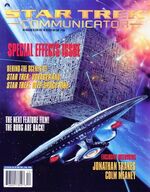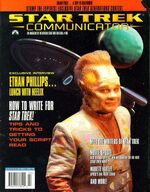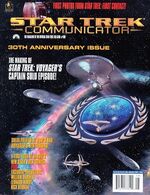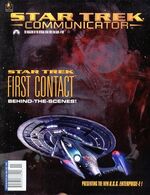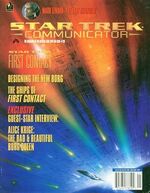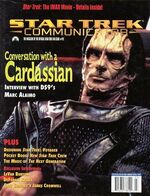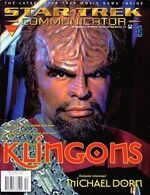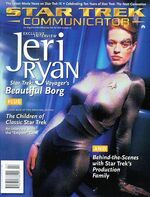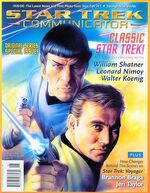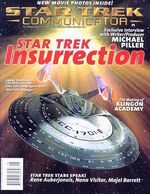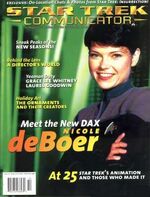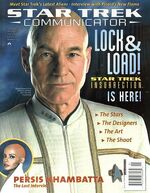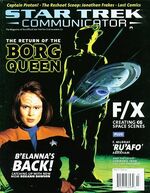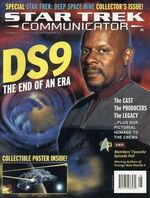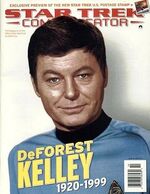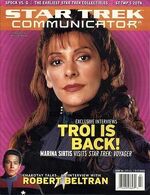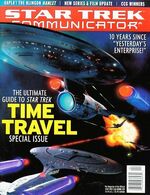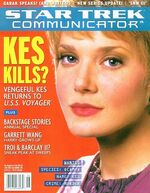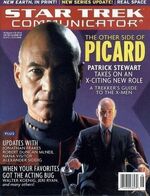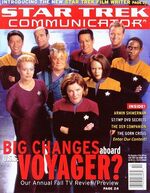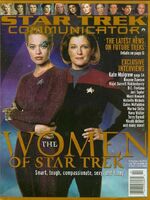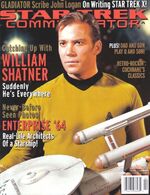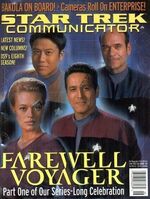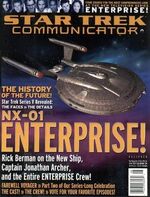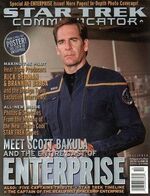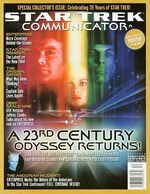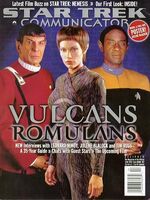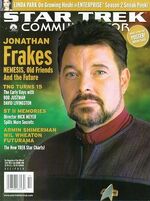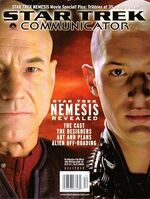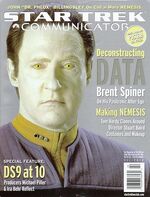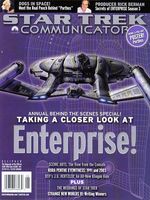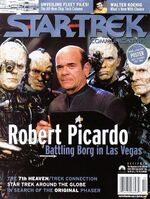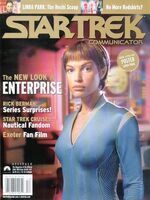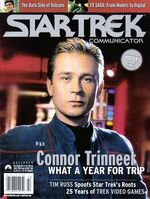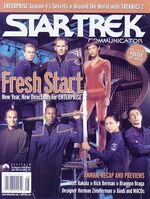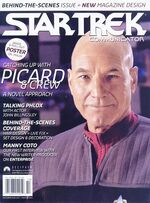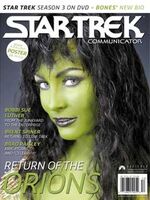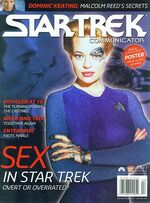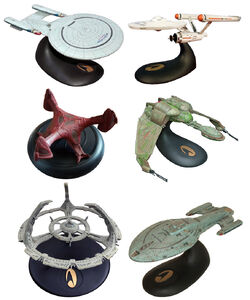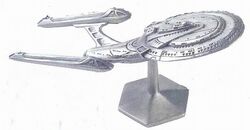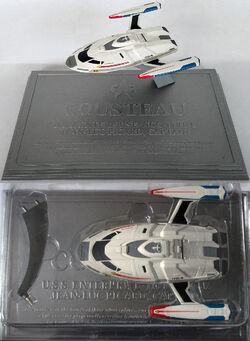Star Trek: Communicator was the main magazine publication of the Official Star Trek Fan Club, and was a progression from the earlier Star Trek: The Official Fan Club Magazine. Published bimonthly, licensed since 1982 and carrying catalog merchadise starting the next year, the title grew from an offset magazine to half-sized format and then full color/full-sized beginning with issue "100", a continuation of the issue numbering from its predecessor. This continuation was intended to emphasize continuity, with indeed no staff or scope changes (aside from the new title/nameplate, which changed at least once over the succeeding years).
On 9 February 2001, Decipher purchased the assets of FANtastic Media, including the fan club, and continued publication of Communicator.
In 2005, the company announced the cancellation of the magazine after issue 155, walking away from the entire Star Trek Fan Club license amid the collapse of the card gaming industry that was its primary focus. Decipher cited complaints about subscription mailing delays and the threat of lawsuits. [1]
Attempts to revive the club and publication by creator/club founder Dan Madsen and its managing editor Larry Nemecek in 2007, amid the uncertainty in the franchise and its owners after the Viacom split into CBS and Paramount, proved unsuccessful.
Recurrent sections
- Note: a concerted effort was made to group articles and interviews that shared similarities into sections, though both section contents as well as section headings changed several times over the publication's run. A typical subdivision was:
- Dossier
- Readers' letters
- Briefing
- News on upcoming episodes, information on Trek actors, sets, behind-the-scenes, etc.
- Profile
- Information and interviews with actors and actresses in Trek
- Tech
- Specifications of ships and stations, and the current stage of future Star Trek technology ("Treknology" being coined for this column)
- Media
- Star Trek gaming
- Quark's Bazaar
- Catalog of items for sale from the fan club, including exclusives of all merchandise types (wearables, model kits, drinkware, etc.)
International editions
The magazine saw an internationally released variant in the form of the edited Italian language Star Trek: La Rivista Ufficiale, which was published between 1997 and 2000 by Fanucci Editore. From 2000 onward, publication of the magazine was taken over by the official Italian Star Trek fanclub, STIC, with a restarted numbering as (Inside) Star Trek magazine.
A second international edition concerned the edited German-language Trekworld publication from the "Star Trek Central Europe" (STCE) fanclub, the later and studio-licensed "Offizieller Star Trek Fan Club" (OSTFC) as of 2000. [2] Between 1986 and 1999, the fanclub released 64 issues under the auspices of editor-in-chief and fanclub president Dirk Bartholomä, starting out very much like Communicator's predecessor The Official Fan Club Magazine, and likewise transitioning into a FANtastic Media "semi-pro" version-style format over the course of its existence. [3] This was unlike its younger Italian counterpart, which had been "semi-pro" from its start.
Core content for both foreign editions was direct translations of the American source publication(s), but each in addition added original material of their own, separately, by local Italian or German writers.
Issues
Starship replica exclusives
A number of "limited edition" cold-cast resin Star Trek starship miniatures, measuring from eight to twelve inches in length, were produced in 1996 by Legends in 3 Dimensions for the fan club and sold through mail order around the turn of the millennium. Advertised as fanclub exclusives and retailed through issues of the Star Trek Communicator magazine, these replicas were also sold at Las Vegas' Star Trek: The Experience, with editions limited to 2,500 models per ship.
The series consisted of replicas of the USS Enterprise, Deep Space 9, Klingon Bird-of-Prey, USS Enterprise-D, USS Voyager, and T'Plana-Hath, the latter mastered by its designer, John Eaves.
A small pewter miniature of the USS Enterprise-E was also retailed by mail order through Star Trek Communicator magazines during the same era. Produced by Rawcliffe in 1997, the miniature was a homage to the legendary gaming miniatures released by former licensor FASA over a decade before, and was duly executed in the approximate 1:3900 game scale.
The Captain's yacht Cousteau miniature was produced by an unknown manufacturer and executed in PVC rather than cold-cast resin, and like the T'Plana-Hath, was designed and mastered by John Eaves. Limited to 5000 pieces, the Cousteau model came with a stand that resembled the vessel's dedication plaque.
As with the Playmates Toys version of the ship, the upright position of the yacht's nacelle pylons (while in flight mode) was changed to a downward cant by Star Trek: Insurrection's producers after the products had been mastered, resulting in discrepancies between the onscreen appearance of the ship and its contemporary miniature replicas. Eaves also commented that the ship's deflector array had undergone some late modifications for use in the film. [4]
